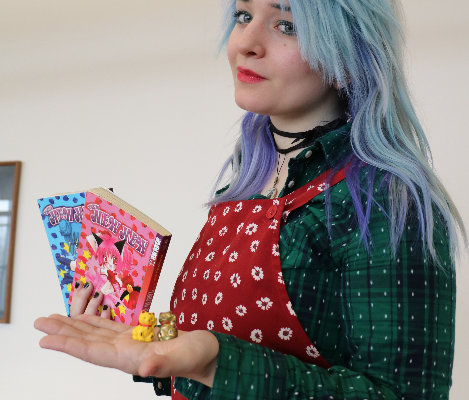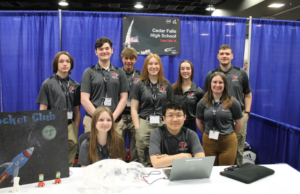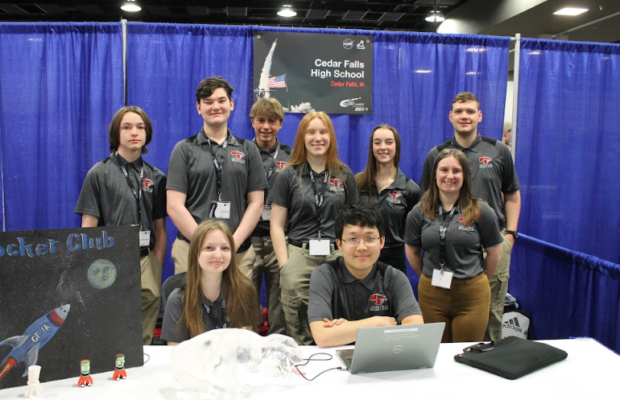Student turns dumplings into taste for land of the rising sun, promise of persistence

By: Mia Blair
I have always been interested in learning foreign language. In 2010, I was in my second year of Latin and my first year of Greek, but it was really to aid in speaking English more eloquently, and I thought it was time to learn something different. People often ask if I began studying Japanese because of my interest in anime, manga and cosplay, but it wasn’t until I began studying the language that I fell in love with the culture.
I knew an elderly Japanese woman at my church, named Taeko (meaning,“mysterious child” or “blessing child”), and I asked her if she could teach me Japanese. She happily agreed, but under one condition: “You make me dumpling?” she asked, a sparkle in her otherwise milky cataracts.
So, a week later, I began my first lesson with her. We wrote on an old, dried out, yellow notepad that she carefully pulled out of her red alligator purse. Where the notepad crumbled at the edges, the yellow had faded to white. Today, I sometimes still find britttle flakes of the notepad in old moving boxes.
She taught me traditional greetings, everyday objects, how to ask questions, colors, numbers, history and even pop-culture. She began visiting my house every Monday to eat dinner with my family. When I answered the door, I would see her gap-toothed smile and would be greeted with “Kon ban wa [Good, evening]!” with a bow, and I would say, “Haijimemashite,” which basically means “Welcome.”
She’d say, “Please take care of me [Dozo yoroshiku],” which is a traditional Japanese greeting. I was corrected many times, and she would not come in until I said it right.
When we sat at the table, we’d say, “Domo arigatou,” which means “Thank you very much.” It is said to show gratitude for the food. Her face was always beaming; she’d look excitedly for dumplings with her leathery hands folded in front of her face and covering up her smile, like she was embarrassed. (I thought it was one of the cutest habits I’d ever seen. Years later, I did find that this may be considered polite.)
I was nervous when I looked up a recipe for traditional Japanese dumpling soup. I’m thinking that if I didn’t make it correctly, it might taste terrible. What was I to do? I had never eaten dumplings before, so I didn’t know how they were even supposed to taste. I enlisted my sister, an aspiring chef, to help me, and it ended up tasting “oishii [delicious],” but I still had no idea if they’d be accurate.
On that day of the first taste, when she was about to take a bite, she paused.
“I did not eat dumpling since 19 and 60,” she said. To my relief, she chuckled at the first bite. She smiled throughout the whole meal and thanked us again and again.
After dinner was finished, she told us stories of being a little girl in Japan in the middle of World War II. Her father was killed in battle, leaving her mother to care for her and her 4-year-old sister, Chiyo.
When she was 9 years old and her mother was working hard to pay for her education, she would always get in trouble. One day, she spoke out of turn in class, and the sensei made the “bad children” lay in a line on the ground, and he hit the backs of their legs with a switch. She had sore, bruised legs when she got home and a very worried mother. Her legs would easily turn black and blue, due to her early onset diabetes. Her mother had no money to take her to a doctor, let alone to pay for school.
Taeko-san also told us that when she was a young school girl, she’d always lay her uniform, her only other set of clothes, under a bamboo mat on the floor. This was so that when she slept on it, it would lay flat, since she had no other way to make it ironed. If it wasn’t completely straight, she’d get switched again.
In her home, there was only one, very scratchy blanket to keep her and Chiyo warm. They slept by a fire while their mother went away to work in a tea house. By morning, Taeko was already awake and doing house chores.
On the morning of Aug. 6, 1945, the sun was almost risen, but Taeko’s little sister was awoken by a sudden, abnormal light on the horizon. It was far away, but very bright. She would later find out that it was the decimation of Hiroshima. Many of her relatives lived a few miles away, but they had been severely injured by radiation, and some died from the blast.
As our relationship grew, every week Taeko-san would ask for dumplings, teach me to make ramen (the real kind) or devilled eggs or onigiri, and she’d always tell us more stories. I remember eating so many dumplings that I became sick of them. I couldn’t even bring myself to make any more dumplings.
But she’d still want them, so we made bento (box lunches) for her to take home, and she kept teaching me.
Eventually, she told me to call her “Oba-san,” which means “grandma,” and she almost stopped teaching me Japanese completely for a while. She ended up just visiting, and we would enjoy our time together. She brought over karaoke videos, and we would have a blast making fools of ourselves. Well, it was more from me attempting to pronounce the Japanese words and her laughing at my failure.
 The next time she came, it was not a happy visit. Hanako, Taeko’s daughter, had driven to our house when Hanako’s son, Akira, had kicked a hole in the wall of her house and broke several dishes. I never met Akira, and for good reasons. Taeko mentioned that he had violent outbursts and didn’t want him at her house, but they had nowhere else to stay. Hanako didn’t speak English very well. All I could make out was that she was saying something like “sorry for intruding” a lot. Taeko was stressed out, so I made some tea. Hanako thanked me for the tea but didn’t talk much after that. Taeko explained that Hanako’s husband went to deal with Akira. Apparently he punched a cop because he didn’t feel like speaking English, so they arrested him and concluded that he would need intense therapy for his anger issues.
The next time she came, it was not a happy visit. Hanako, Taeko’s daughter, had driven to our house when Hanako’s son, Akira, had kicked a hole in the wall of her house and broke several dishes. I never met Akira, and for good reasons. Taeko mentioned that he had violent outbursts and didn’t want him at her house, but they had nowhere else to stay. Hanako didn’t speak English very well. All I could make out was that she was saying something like “sorry for intruding” a lot. Taeko was stressed out, so I made some tea. Hanako thanked me for the tea but didn’t talk much after that. Taeko explained that Hanako’s husband went to deal with Akira. Apparently he punched a cop because he didn’t feel like speaking English, so they arrested him and concluded that he would need intense therapy for his anger issues.
The next summer, she went away with Hanako to visit family in Japan. Four months later, she returned with omiyage (gifts or souvenirs) from the island of Hokkaido. She brought two very tiny, golden cat figurines, called maneki neko, or “welcoming (lucky) cats” (pictured at left). She had a new yukata (a lighter, more summery kind of clothing, similar to a kimono, both of which are very difficult to tie properly), and hashi (chopsticks), which were hand carved by an Ainu (aboriginal people, mostly living in Hokkaido and Honshu) man she met at a shop.
There were delicate hana (flowers) painted around the top.
She also brought a similarly-patterned red apron (pictured left), which is almost as confusing as the yukata. It’s all twisted around and buttoned in weird places, and it takes us a while to untwist it.
I thanked her for the gifts, and she went home. I didn’t see her many times after that because I moved to Iowa, and she was in Texas, recovering from a cataract surgery and being treated for diabetes.
I don’t know her exact whereabouts today, but the last I heard of her was a phone call with Hanako. Taeko was not doing well, but she did relay a message to me I will not forget: “Yakusoku shite kudasai.” It means, “please promise me.”
I do believe she is in tengoku (heaven), and I’ve grown to accept it. I am not sure what she wanted me to promise, but I did promise her that I would become fluent in Japanese for her, no mattter how difficult it can be. I will not give up.
I won’t forget Oba-aan. Without her, I would not be the same person I am today.









You must be logged in to post a comment Login